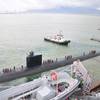United Marine International (UMI), Division of Liquid Waste Technology, Inc., USA, has emerged as the world's leading producer of Marine Trash Skimmers. UMI designs and manufactures Water Management Boats to remove from waterways all types and sizes of floating debris, aquatic vegetation and related pollutants...anything and everything that "washes" out of watersheds after snow melts, "spring runoff" and rainstorms...natural debris, street litter, man-make "flotables", and garbage. All this pollution eventually finds it way into our ports and harbors.
Today there are over 60 UMI TRASHCAT™ skimmer boats in operation throughout the world. New York, Paris, Washington, DC, Chicago, Ft. Lauderdale, Dubai, Rio de Janeiro, Singapore, Hong Kong, and Baltimore, all providing cleaner and safer recreational and commercial waterways to their residents and visitors with their UMI TRASHCAT™ skimmer vessels. UMI's WEEDCAT™ Aquatic Weed Harvester equipment removes both floating and rooted nuisance aquatic plants from ponds, lakes, reservoirs, marinas, hydroelectric reservoirs, etc.
UMI's most recent delivery, a repeat order from Passaic Valley Sewerage Commissioners (PVSC), Newark, New Jersey, is UMI's smallest Model #MS8-1500A TRASHCAT™. PVSC, which is responsible for removing floating debris from Newark Bay (part of the New York harbor estuaries) and the Passaic River, took delivery of this TRASHCAT™ in October 2001. A low-silhouette boat (equipped with a "side-cab"), UMI specially designed the skimmer so it could travel under low clearance bridges, enabling it to reach otherwise inaccessible and confined areas in the upper reaches of the Passaic River. You can find more information about PVSC's TRASHCAT™ operations on their web site at www.pvsc.com, as well as additional PVSC stories on UMI's News Section.
The Passaic Valley TRASHCAT™, requiring just one operator (and possibly an assistant for added safety), features articulating conveyorized wings capable of efficiently recovering floating trash with an 8 ft. (2.44 m) wide swath and delivering the debris to the vessels on-board storage containment area, which has a capacity of up to 1500 lbs (680 kgs) or 120 cu.ft. (3.4 cu.m.).
Featured videos

Tracking Foreign Vessels Working in the U.S. Jones Act Market

Inside the Electrified Truckable Tug

Inmarsat Enhances Service to Drive Digitalization
Subscribe for
Maritime Reporter E-News
Maritime Reporter E-News is the maritime industry's largest circulation and most authoritative ENews Service, delivered to your Email five times per week









